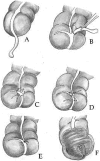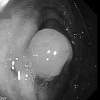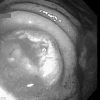Appendiceal inversion: a diagnostic and therapeutic dilemma
- PMID: 19366551
- PMCID: PMC3015910
Appendiceal inversion: a diagnostic and therapeutic dilemma
Abstract
Appendiceal inversion is an uncommon entity that presents a diagnostic dilemma for the gastroenterologist or surgeon. We present 2 cases that illustrate scenarios that may be encountered during colonoscopy. A discussion of the literature on this subject is also presented. An improved awareness of this condition will assist the endoscopist in the identification of this finding and direct the appropriate expectant management.
Figures





References
-
- Jevon GP, Daya D, Oizilbash AH. Intussusception of the appendix. A report of four cases and review of the literature. Arch Pathol Lab Med. 1992;116(9):960–964 - PubMed
-
- Voeller GR, Fabian TC. Inversion-ligation appendectomy for incidental appendectomy. Am J Surg. 1991;161(4):483–484 - PubMed
-
- Van Fleet RH, Shabot JM, Halpert RD. Adenocarcinoma of the appendiceal stump. South Med J. 1990;83:1351–1353 - PubMed
-
- Shami VM, Yerian LM, Waxman I. Adenoma and early stage adenocarcinoma of the appendix: diagnosis by colonoscopy. Gastrointest Endosc. 2004;59:731–733 - PubMed
-
- Hardin RD. Colonoscopic diagnosis of an appendiceal polyp with carcinoma in situ. J Clin Gastroenterol. 1986;8:189–191 - PubMed
Publication types
MeSH terms
LinkOut - more resources
Full Text Sources
